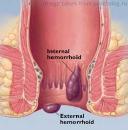
Digestion & Digestive Health - Hemorroids
Hemorrhoids
Hemorrhoids or haemorrhoids, are normal vascular structures in the anal canal which help with stool control. An exact definition of hemorrhoids does not exist, but they can be described as masses or clumps ("cushions") of tissue within the anal canal that contain blood vessels and the surrounding, supporting tissue made up of muscle and elastic fibers.  They become pathological or known as piles when swollen or inflamed. In their physiological state they act as cushions composed of arterio-venous channels and connective tissue that aid the passage of stool. Although most people think hemorrhoids are abnormal, they are present in everyone. It is only when the hemorrhoidal cushions enlarge that hemorrhoids can cause problems and be considered abnormal or a disease. Hemorrhoids that cause problems are found equally in men and women, and their prevalence peaks between 45 and 65 years of age.
They become pathological or known as piles when swollen or inflamed. In their physiological state they act as cushions composed of arterio-venous channels and connective tissue that aid the passage of stool. Although most people think hemorrhoids are abnormal, they are present in everyone. It is only when the hemorrhoidal cushions enlarge that hemorrhoids can cause problems and be considered abnormal or a disease. Hemorrhoids that cause problems are found equally in men and women, and their prevalence peaks between 45 and 65 years of age.
By far the most common cause of hemroids is constipation. This can be as a result of a number of factors, notable among which is poor diet. A diet lacking in sufficient fibrous content and water can lead one to developing hemroids. Hemroids also develop as a result of overweight or obesity. An obese person exerts a lot of weight on the lower abdomen and this leads to excessive pressure building up in the anal system. Excessive pressure is also required by such a person to pass even small amounts of stool. Such amounts of pressure repeatedly applied will eventually cause the anal veins to swell and in turn constrain the process of passing stool. This vicious circle gives rise to hemroids in the long run. In the same way, people who lift heavy loads and pregnant women are also susceptible to hemroids because of pressure build-up in the lower abdomen.
Right from its early stages hemroids symptoms are not difficult to diagnose. However caution should be exercised in doing so in order not to confuse other ailments like abscess or herpes with hemroids. Some of the tell-tale signs of hemroids are:
- An inflamed and itchy anus.
- Swollen veins inside the anal canal. The anal canal is the last four centimeters through which stool passes as it goes from the rectum to the outside world. The anus is the opening of the anal canal to the outside world.
- Stool stained with blood. This results from friction between hard stools and the anal walls.
- Prolapsed tissue from the anus. This is especially observable in later stages of internal hemroids.
Types of hemroids
There are basically two types of hemroids: internal hemroids and external hemroids. The former develops inside the anus and rectum but can sometimes be seen as protruding tissue from the anus opening. This may come about if the hemroids are left to grow beyond manageable levels without proper treatment.
External hemroids on the other hand are mainly observed on the surface near the opening of the anus.
It is believed generally that constipation and straining to have bowel movements promote hemorrhoids and that hard stools can traumatize existing hemorrhoids. It is recommended, therefore, that individuals with hemorrhoids soften their stools by increasing the fiber in their diets. Fiber is found in numerous foodstuffs including fresh and dried fruits, vegetables, grains, and cereals.
Diarrhea is believed to aggravate the symptoms of hemorrhoids and it is recommended that diarrhea be controlled with fiber and anti-motility drugs.